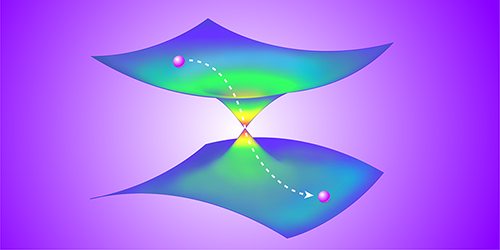Quantum Circuit Tackles “Diabolical” Photochemical Process
Experts anticipate that chemistry calculations will be “killer apps” for quantum processors. To that aim, they are developing quantum devices that can model complex chemical processes. Now Christopher Wang and colleagues at Yale University have engineered a superconducting circuit that simulates one such process: the evolution of a quantum wave packet in the proximity of a “conical intersection”—a particular configuration of a molecular energy potential [1]. Similar dynamics occur when a photon hits rhodopsin, a photoreceptor molecule in the eye, making conical intersections relevant to vision.
Conical intersections appear when a molecule’s ground and excited electronic states cross to form a cone-shaped energy potential. When that happens, the motions of the molecule’s electrons and nuclei are strongly coupled. This coupling breaks down a theoretical approximation that enables calculations of the system’s electronic structure and dynamics, which is why theorists have dubbed conical intersections “diabolical” [2].
To build their conical-intersection simulator, Wang and colleagues coupled a superconducting qubit to two microwave cavities. In this system, the states of the qubit represent the electronic states of a molecule and the oscillations of the cavities represent the nuclear motion. Using tailored microwave pulses, they programmed this system to have the same Hamiltonian as one with a conical intersection. Through quantum tomography measurements, they showed that the evolution of the system’s quantum states exactly reproduces that of a quantum wave packet passing through a conical intersection.
The team acknowledges that the simulated conical intersection is too simple to be chemically interesting. However, Wang says that their demonstration shows that quantum devices can be programmed to precisely replicate specific Hamiltonians. He says that, with further improvements, the device could “form a building block for something that has true computational power.”
–Matteo Rini
Matteo Rini is the Editor of Physics Magazine.
References
- C. S. Wang et al., “Observation of wave-packet branching through an engineered conical intersection,” Phys. Rev. X 13, 011008 (2023).
- D. R. Yarkony, “Diabolical conical intersections,” Rev. Mod. Phys. 68, 985 (1996).




